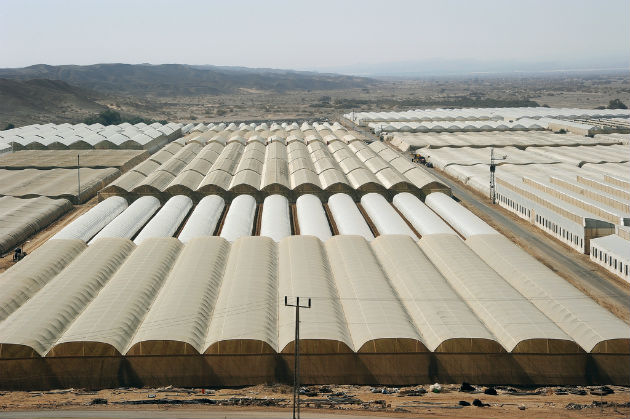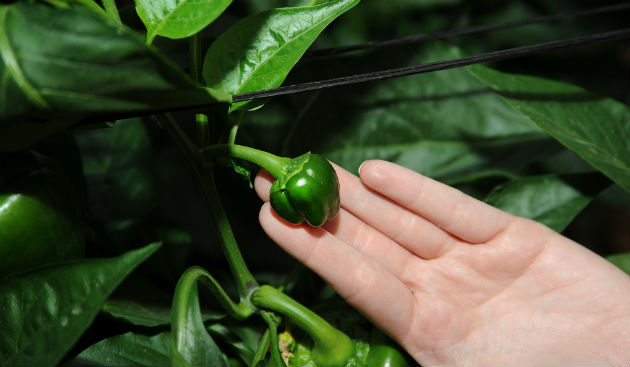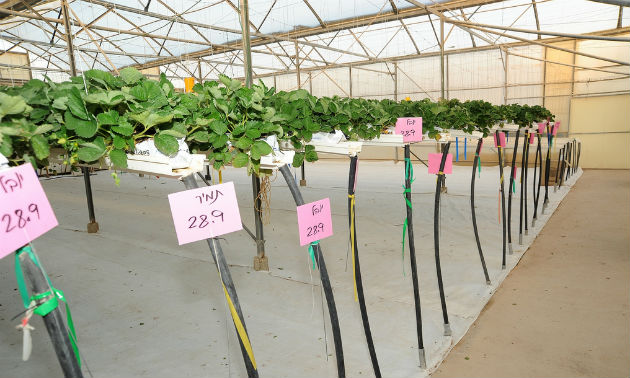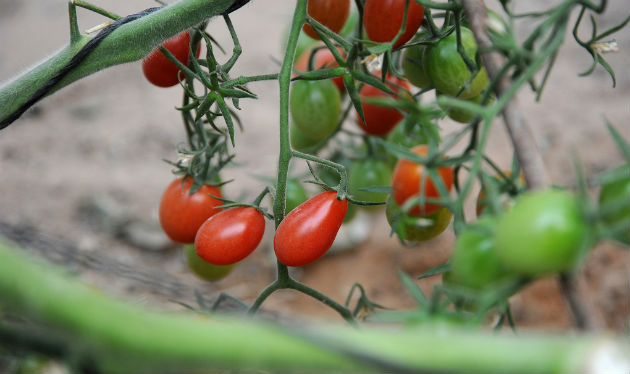Once a barren strip of desert, the Arava today has some 600 farms supplying more than 60 percent of Israel’s exports of fresh vegetables and 10% of ornamentals.

Peppers growing in the Arava. Photo by Eyal Izhar
How many peppers can Peter Piper pick? Well, if the protagonist in the old tongue twister were picking them in Israel’s Arava Desert, the surprising answer is about 150,000 tons.
Once a deserted 112-mile strip of land stretching from the Dead Sea to the Red Sea, the Arava now has some 600 farms supplying more than 60 percent of total Israeli exports of fresh vegetables and about 10% of ornamentals.
In addition to dozens of varieties of peppers, Arava farmers produce tomatoes, cherry tomatoes, eggplants, melons, watermelons, table grapes, herbs and dates – many raised organically and all with minimal pesticides. Other Arava agriculturists specialize in flowers or aquarium fish such as the “Nemo” clownfish.
Israeli technology – most notably, drip irrigation – is a major factor in this desert-to-farmland story. But just as important is the constant sharing of ideas, methodology, research and experiences facilitated by Central and Northern Arava Research and Development.
Cooperation key to success
Arava R&D, founded in 1986 by the Jewish Agency, originally served the agriculture development needs in periphery areas. Idealistic would-be farmers, eager to make the proverbial desert bloom, already had established three kibbutzim in the Arava back in 1959.
“They were considered meshugenners, crazy people,” relates Aylon Gadiel, director of Arava R&D. “You couldn’t live in the Arava, let alone grow vegetables there. But it was proven that it is possible, and one reason is the development of drip irrigation in the beginning of the 1960s.”
Zohar Experimental Station, one of Arava R&D’s two research facilities, is named for Yuval Zohar, an Israeli pioneer of modern drip irrigation.
Yet this advance alone was not enough to turn Arava agriculture into a thriving venture. Neither were the innovative greenhouses, shade houses and walk-in plastic tunnels that the desert farmers put into use.
By 1997, when the Jewish National Fund took over Arava R&D in cooperation with the Ministry of Agriculture and Rural Development and other government agencies, regional councils and private sponsors, it was already clear that cooperation is the main ingredient of success.
The researchers, scientists and farmers involved in Arava R&D’s eight agricultural villages – comprising about 8,650 acres – interact through regularly scheduled site tours, seminars and online forums in order to learn about one another’s problems and solutions, Gadiel tells ISRAEL21c.
“You can see what the growers are doing, and they can see what you think could help. Some farmer may be trying something new and we will go test it on an academic level,” he explains. “The interaction is ongoing and constant between all the parties. We try to get the knowledge flowing back and forth.”
New farmers in 2012
This year, many new farmers are being trained in basic agriculture, says Gadiel. Instructors from the agricultural extension service, Arava R&D, business and academia teach topics including the most updated methods of irrigation and plant protection.
“We sponsor meetings with R&D people so that they will get to know the farmers and discuss new options in growing,” adds Gadiel. “We’re testing all kinds of things: Our farmers are growing more and more dates, mangos, table grapes and ornamental fish.”
The next promising crop is strawberries. “They cannot grow in saline water, so we’re trying to grow them with desalinated water from a small plant we have in our Yair Experimental Station. We are developing a protocol for that, and we hope we will have good quality water in a couple of years.”
Arava R&D has also developed a hardy variety of fig tree and a less odiferous guava fruit. “We’re trying apricots now, and we developed a protocol for organic table grapes,” Gadiel says.
World model
The United Nations chose the Arava region as a global model for agricultural education on saving water. Israel’s agricultural researchers are constantly improving and refining “fertigation,” in which water and fertilizer are dripped uniformly onto the root system of crops from a specially constructed pipe.
Over the last 15 years, says Gadiel, the Arava has become an international school for agricultural trainees.
“We have a lot of students coming here for year-long projects to study and work with families of Arava farmers — mainly from Thailand, Myanmar and other Far East countries, in cooperation with the Foreign Ministry. When they go back home, each student becomes an ambassador for Israel.”
Experts from Arava R&D travel to countries such as Ethiopia to give practical courses through MASHAV, Israel’s international development agency.
Back on home soil, Arava R&D is working with local companies to develop hardier seed varieties and a new type of plastic covering for greenhouses that would reduce the need for expensive heating in cold months.
“I think Israeli agriculture in general is an example for the whole world of how you can develop an area and live in it, too,” says Gadiel. “We learned how to use our advantages, especially in winter, to produce good-quality vegetables for export to Europe and the United States.”
Last February, Arava R&D hosted its 21st annual Arava Open Day Exhibition, the largest agriculture expo in Israel, attracting 30,000 visitors and 200 companies. The next expo is scheduled for January 23-24, 2013.








I think some of the greenhouses survived, no thanks to Hamas who allowed them to be vandalized by the mental midgets who are it’s followers, and I think they are now shipping produce from them.
I read an amazing article on tomatoes. The tomato has 31000 genes more than a human and began developing in Peru almost a million years ago. Scientists, led by an Israeli researcher who just published an article on tomatoes in Nature, spent years decoding its genome. Potatoes also come from the same family. These are two of my favorite foods.
I don’t know how it was in other places but for decades in the U.S., we had the most horrible tasting tomatoes in the winter, and now I know why. Scientists can tweak tomatoes for different traits, and we got the tomatoes that were tweaked for a long shelf life, but with no good flavor. Everybody complained about this and these tomatoes were a crime! Of course in modern times we do get good tomatoes in the winter for a price, but those awful ones are still around. They never really ripen, they just sit there like coprolites.
Wish I could order vegetables from Israel!
@ dan:
Dan, that’s what morons do.
Mistake was to abandon Gaza.
Not sure G-d was happy with that move or Sinai for that matter.
G-d provided the Holy Land for His people but did not expect those in charge to squander it away.
Too bad Moses doesn’t show up with the tablets and break them over the heads of those secular progressive in charge.
but when israel abandoned gaza and left the grrehouses for the morons there, they deliberately destroyed them